Chemotherapy and Palliative Care for Adult Cancer Patients Report
VerifiedAdded on 2020/04/29
|8
|1719
|95
Report
AI Summary
This report analyzes a research study by Wright et al. (2014) on chemotherapy and palliative care for adult cancer patients. The study, conducted in outpatient oncology clinics across the United States, investigated the impact of chemotherapy on terminally ill cancer patients, comparing the standards of medical care they received, including place of death and survival rates. The study's strengths include a detailed outcome measurement and collection of extensive data, addressing gaps in previous literature regarding chemotherapy and emergency department visits. Limitations include a lack of information on patient decisions and baseline preferences. The report discusses nursing implications, emphasizing the importance of palliative care policies and protocols to safeguard patient interests and preferences, highlighting how the study's findings can inform better care strategies for terminally ill cancer patients. The research highlights the potential adverse consequences of chemotherapy in the final weeks of life and prompts the development of improved patient-centered care plans.
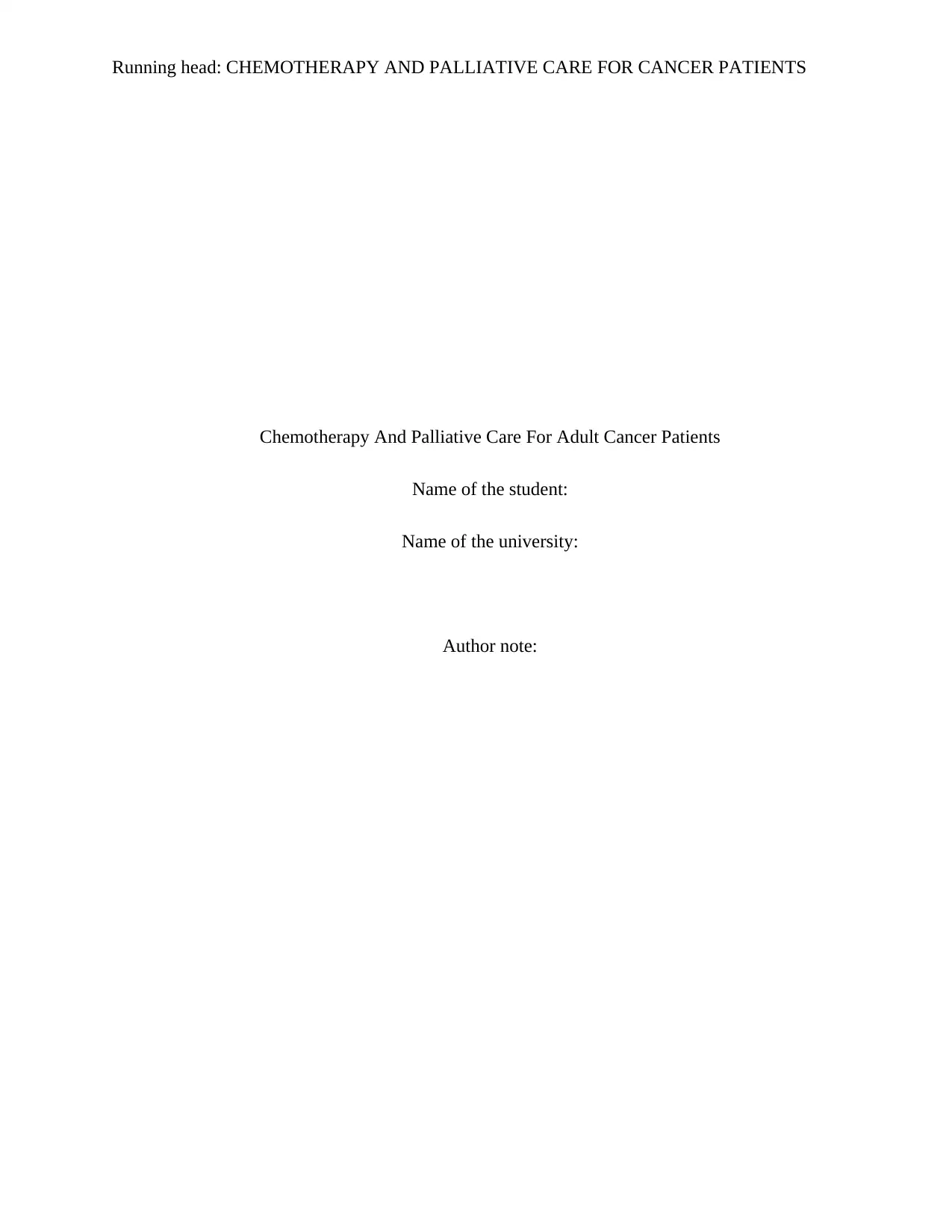
Running head: CHEMOTHERAPY AND PALLIATIVE CARE FOR CANCER PATIENTS
Chemotherapy And Palliative Care For Adult Cancer Patients
Name of the student:
Name of the university:
Author note:
Chemotherapy And Palliative Care For Adult Cancer Patients
Name of the student:
Name of the university:
Author note:
Paraphrase This Document
Need a fresh take? Get an instant paraphrase of this document with our AI Paraphraser
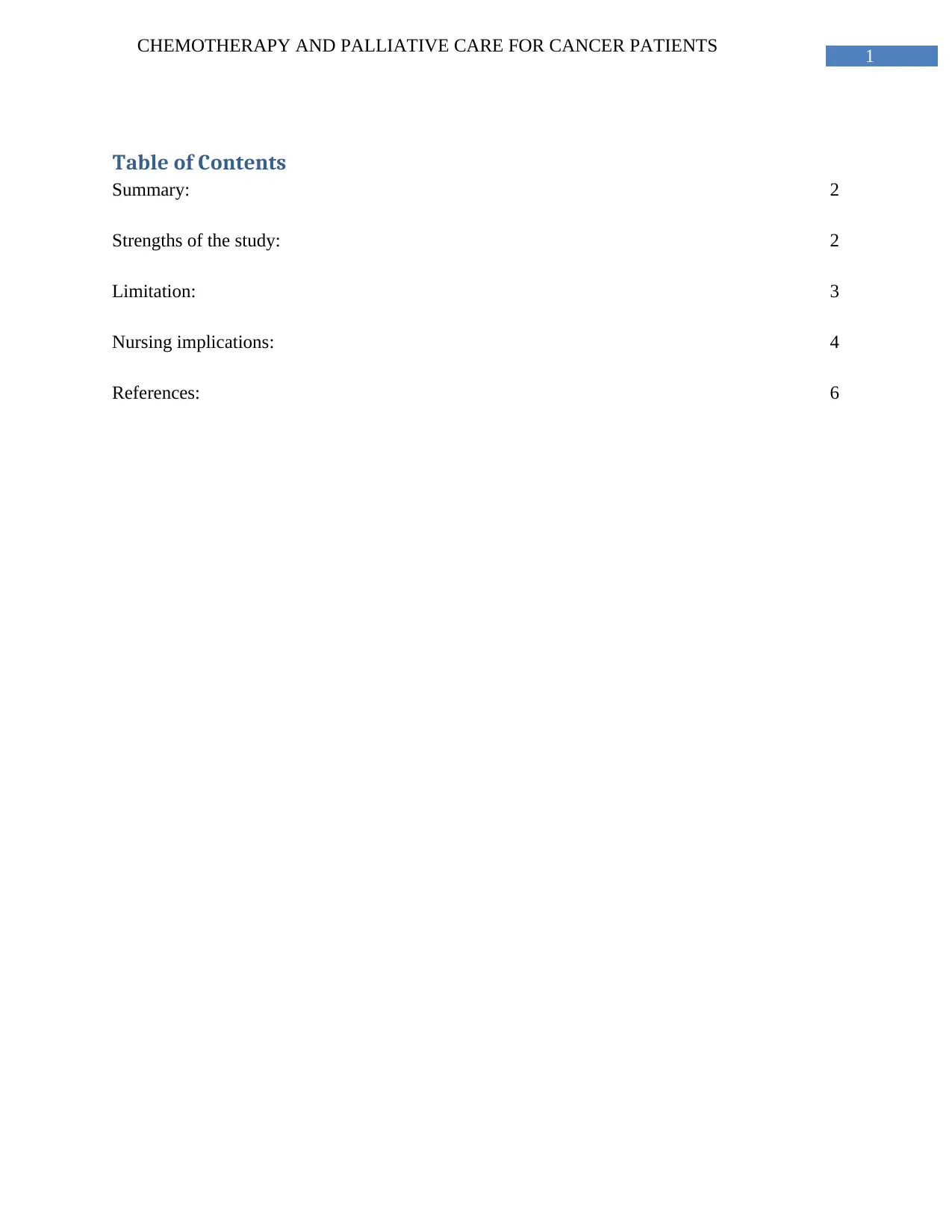
1
CHEMOTHERAPY AND PALLIATIVE CARE FOR CANCER PATIENTS
Table of Contents
Summary: 2
Strengths of the study: 2
Limitation: 3
Nursing implications: 4
References: 6
CHEMOTHERAPY AND PALLIATIVE CARE FOR CANCER PATIENTS
Table of Contents
Summary: 2
Strengths of the study: 2
Limitation: 3
Nursing implications: 4
References: 6
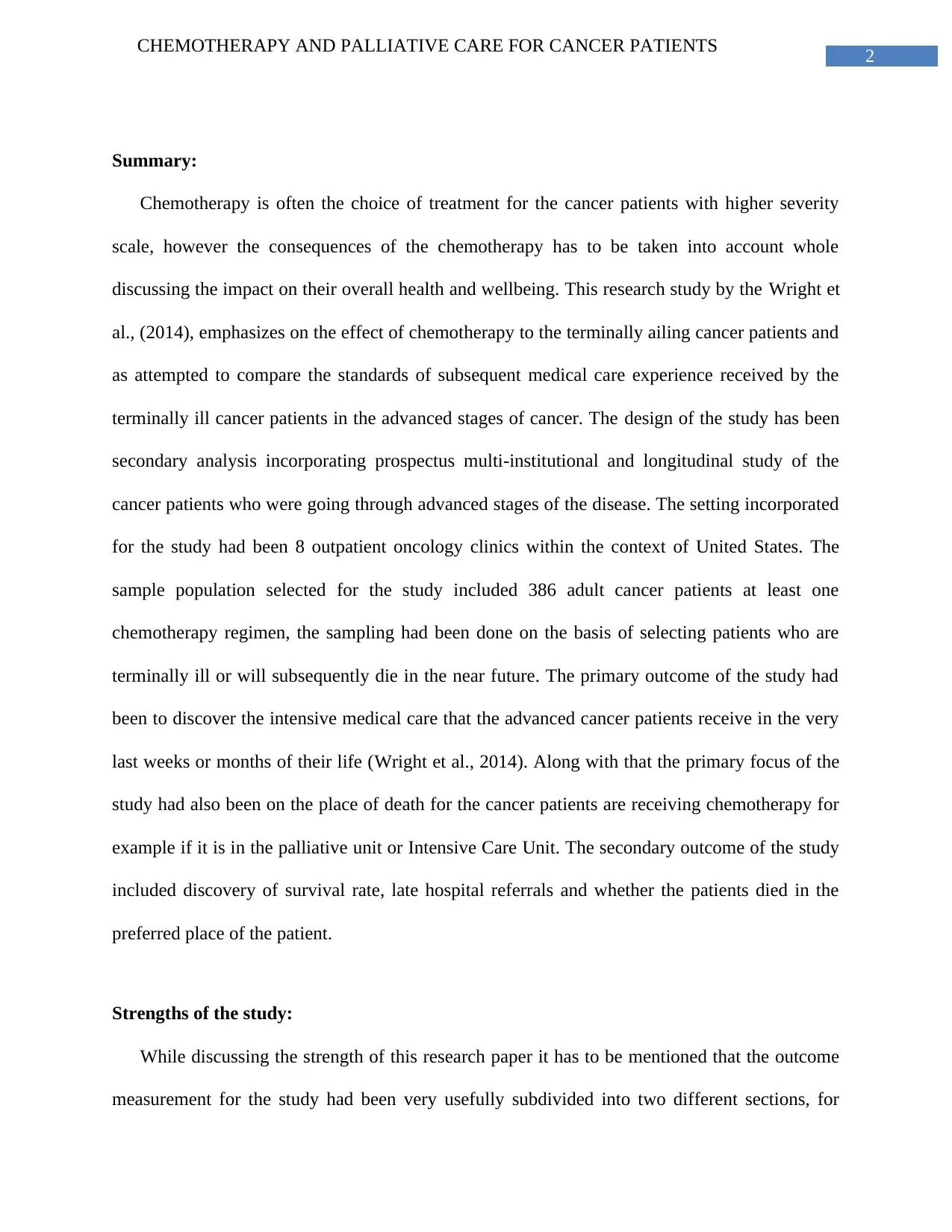
2
CHEMOTHERAPY AND PALLIATIVE CARE FOR CANCER PATIENTS
Summary:
Chemotherapy is often the choice of treatment for the cancer patients with higher severity
scale, however the consequences of the chemotherapy has to be taken into account whole
discussing the impact on their overall health and wellbeing. This research study by the Wright et
al., (2014), emphasizes on the effect of chemotherapy to the terminally ailing cancer patients and
as attempted to compare the standards of subsequent medical care experience received by the
terminally ill cancer patients in the advanced stages of cancer. The design of the study has been
secondary analysis incorporating prospectus multi-institutional and longitudinal study of the
cancer patients who were going through advanced stages of the disease. The setting incorporated
for the study had been 8 outpatient oncology clinics within the context of United States. The
sample population selected for the study included 386 adult cancer patients at least one
chemotherapy regimen, the sampling had been done on the basis of selecting patients who are
terminally ill or will subsequently die in the near future. The primary outcome of the study had
been to discover the intensive medical care that the advanced cancer patients receive in the very
last weeks or months of their life (Wright et al., 2014). Along with that the primary focus of the
study had also been on the place of death for the cancer patients are receiving chemotherapy for
example if it is in the palliative unit or Intensive Care Unit. The secondary outcome of the study
included discovery of survival rate, late hospital referrals and whether the patients died in the
preferred place of the patient.
Strengths of the study:
While discussing the strength of this research paper it has to be mentioned that the outcome
measurement for the study had been very usefully subdivided into two different sections, for
CHEMOTHERAPY AND PALLIATIVE CARE FOR CANCER PATIENTS
Summary:
Chemotherapy is often the choice of treatment for the cancer patients with higher severity
scale, however the consequences of the chemotherapy has to be taken into account whole
discussing the impact on their overall health and wellbeing. This research study by the Wright et
al., (2014), emphasizes on the effect of chemotherapy to the terminally ailing cancer patients and
as attempted to compare the standards of subsequent medical care experience received by the
terminally ill cancer patients in the advanced stages of cancer. The design of the study has been
secondary analysis incorporating prospectus multi-institutional and longitudinal study of the
cancer patients who were going through advanced stages of the disease. The setting incorporated
for the study had been 8 outpatient oncology clinics within the context of United States. The
sample population selected for the study included 386 adult cancer patients at least one
chemotherapy regimen, the sampling had been done on the basis of selecting patients who are
terminally ill or will subsequently die in the near future. The primary outcome of the study had
been to discover the intensive medical care that the advanced cancer patients receive in the very
last weeks or months of their life (Wright et al., 2014). Along with that the primary focus of the
study had also been on the place of death for the cancer patients are receiving chemotherapy for
example if it is in the palliative unit or Intensive Care Unit. The secondary outcome of the study
included discovery of survival rate, late hospital referrals and whether the patients died in the
preferred place of the patient.
Strengths of the study:
While discussing the strength of this research paper it has to be mentioned that the outcome
measurement for the study had been very usefully subdivided into two different sections, for
⊘ This is a preview!⊘
Do you want full access?
Subscribe today to unlock all pages.

Trusted by 1+ million students worldwide
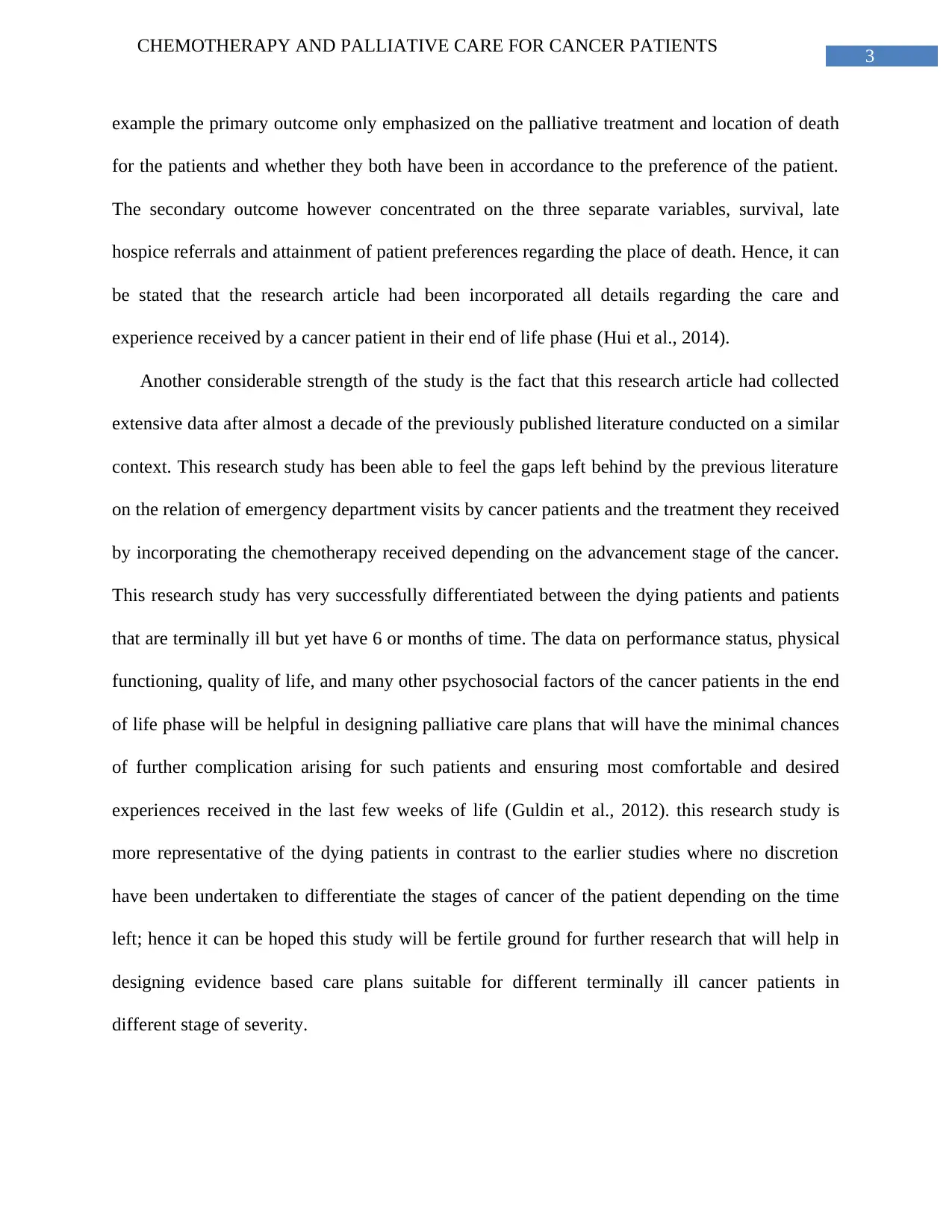
3
CHEMOTHERAPY AND PALLIATIVE CARE FOR CANCER PATIENTS
example the primary outcome only emphasized on the palliative treatment and location of death
for the patients and whether they both have been in accordance to the preference of the patient.
The secondary outcome however concentrated on the three separate variables, survival, late
hospice referrals and attainment of patient preferences regarding the place of death. Hence, it can
be stated that the research article had been incorporated all details regarding the care and
experience received by a cancer patient in their end of life phase (Hui et al., 2014).
Another considerable strength of the study is the fact that this research article had collected
extensive data after almost a decade of the previously published literature conducted on a similar
context. This research study has been able to feel the gaps left behind by the previous literature
on the relation of emergency department visits by cancer patients and the treatment they received
by incorporating the chemotherapy received depending on the advancement stage of the cancer.
This research study has very successfully differentiated between the dying patients and patients
that are terminally ill but yet have 6 or months of time. The data on performance status, physical
functioning, quality of life, and many other psychosocial factors of the cancer patients in the end
of life phase will be helpful in designing palliative care plans that will have the minimal chances
of further complication arising for such patients and ensuring most comfortable and desired
experiences received in the last few weeks of life (Guldin et al., 2012). this research study is
more representative of the dying patients in contrast to the earlier studies where no discretion
have been undertaken to differentiate the stages of cancer of the patient depending on the time
left; hence it can be hoped this study will be fertile ground for further research that will help in
designing evidence based care plans suitable for different terminally ill cancer patients in
different stage of severity.
CHEMOTHERAPY AND PALLIATIVE CARE FOR CANCER PATIENTS
example the primary outcome only emphasized on the palliative treatment and location of death
for the patients and whether they both have been in accordance to the preference of the patient.
The secondary outcome however concentrated on the three separate variables, survival, late
hospice referrals and attainment of patient preferences regarding the place of death. Hence, it can
be stated that the research article had been incorporated all details regarding the care and
experience received by a cancer patient in their end of life phase (Hui et al., 2014).
Another considerable strength of the study is the fact that this research article had collected
extensive data after almost a decade of the previously published literature conducted on a similar
context. This research study has been able to feel the gaps left behind by the previous literature
on the relation of emergency department visits by cancer patients and the treatment they received
by incorporating the chemotherapy received depending on the advancement stage of the cancer.
This research study has very successfully differentiated between the dying patients and patients
that are terminally ill but yet have 6 or months of time. The data on performance status, physical
functioning, quality of life, and many other psychosocial factors of the cancer patients in the end
of life phase will be helpful in designing palliative care plans that will have the minimal chances
of further complication arising for such patients and ensuring most comfortable and desired
experiences received in the last few weeks of life (Guldin et al., 2012). this research study is
more representative of the dying patients in contrast to the earlier studies where no discretion
have been undertaken to differentiate the stages of cancer of the patient depending on the time
left; hence it can be hoped this study will be fertile ground for further research that will help in
designing evidence based care plans suitable for different terminally ill cancer patients in
different stage of severity.
Paraphrase This Document
Need a fresh take? Get an instant paraphrase of this document with our AI Paraphraser
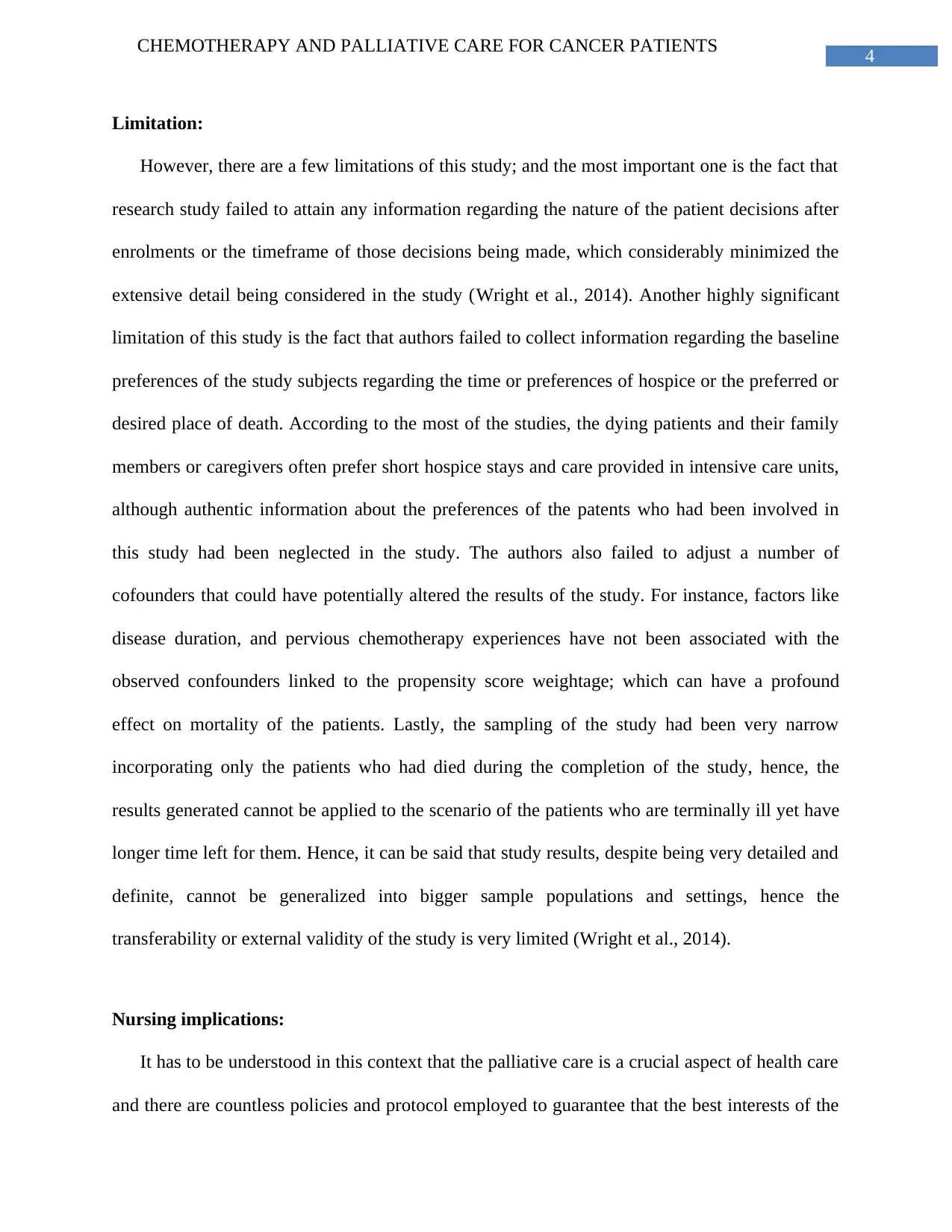
4
CHEMOTHERAPY AND PALLIATIVE CARE FOR CANCER PATIENTS
Limitation:
However, there are a few limitations of this study; and the most important one is the fact that
research study failed to attain any information regarding the nature of the patient decisions after
enrolments or the timeframe of those decisions being made, which considerably minimized the
extensive detail being considered in the study (Wright et al., 2014). Another highly significant
limitation of this study is the fact that authors failed to collect information regarding the baseline
preferences of the study subjects regarding the time or preferences of hospice or the preferred or
desired place of death. According to the most of the studies, the dying patients and their family
members or caregivers often prefer short hospice stays and care provided in intensive care units,
although authentic information about the preferences of the patents who had been involved in
this study had been neglected in the study. The authors also failed to adjust a number of
cofounders that could have potentially altered the results of the study. For instance, factors like
disease duration, and pervious chemotherapy experiences have not been associated with the
observed confounders linked to the propensity score weightage; which can have a profound
effect on mortality of the patients. Lastly, the sampling of the study had been very narrow
incorporating only the patients who had died during the completion of the study, hence, the
results generated cannot be applied to the scenario of the patients who are terminally ill yet have
longer time left for them. Hence, it can be said that study results, despite being very detailed and
definite, cannot be generalized into bigger sample populations and settings, hence the
transferability or external validity of the study is very limited (Wright et al., 2014).
Nursing implications:
It has to be understood in this context that the palliative care is a crucial aspect of health care
and there are countless policies and protocol employed to guarantee that the best interests of the
CHEMOTHERAPY AND PALLIATIVE CARE FOR CANCER PATIENTS
Limitation:
However, there are a few limitations of this study; and the most important one is the fact that
research study failed to attain any information regarding the nature of the patient decisions after
enrolments or the timeframe of those decisions being made, which considerably minimized the
extensive detail being considered in the study (Wright et al., 2014). Another highly significant
limitation of this study is the fact that authors failed to collect information regarding the baseline
preferences of the study subjects regarding the time or preferences of hospice or the preferred or
desired place of death. According to the most of the studies, the dying patients and their family
members or caregivers often prefer short hospice stays and care provided in intensive care units,
although authentic information about the preferences of the patents who had been involved in
this study had been neglected in the study. The authors also failed to adjust a number of
cofounders that could have potentially altered the results of the study. For instance, factors like
disease duration, and pervious chemotherapy experiences have not been associated with the
observed confounders linked to the propensity score weightage; which can have a profound
effect on mortality of the patients. Lastly, the sampling of the study had been very narrow
incorporating only the patients who had died during the completion of the study, hence, the
results generated cannot be applied to the scenario of the patients who are terminally ill yet have
longer time left for them. Hence, it can be said that study results, despite being very detailed and
definite, cannot be generalized into bigger sample populations and settings, hence the
transferability or external validity of the study is very limited (Wright et al., 2014).
Nursing implications:
It has to be understood in this context that the palliative care is a crucial aspect of health care
and there are countless policies and protocol employed to guarantee that the best interests of the
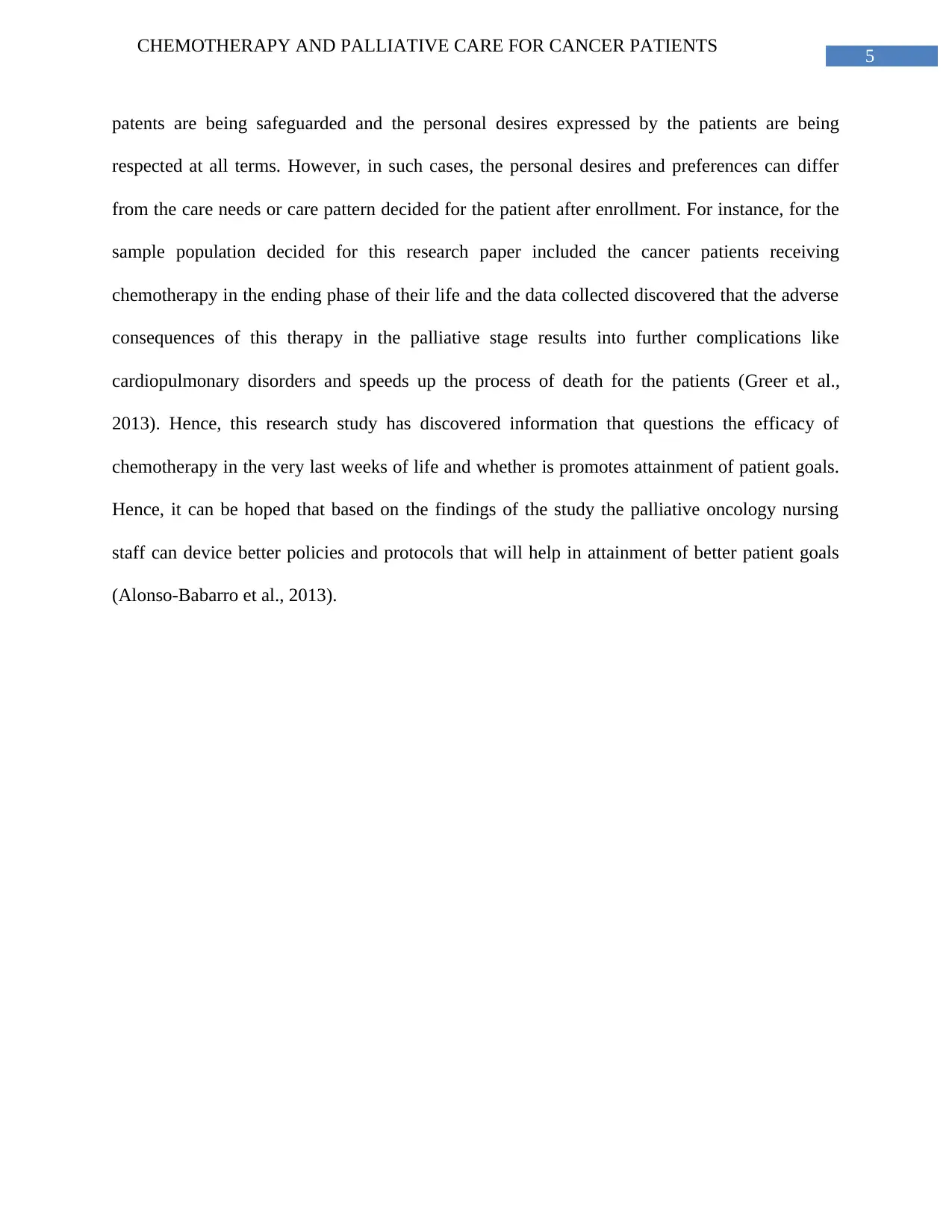
5
CHEMOTHERAPY AND PALLIATIVE CARE FOR CANCER PATIENTS
patents are being safeguarded and the personal desires expressed by the patients are being
respected at all terms. However, in such cases, the personal desires and preferences can differ
from the care needs or care pattern decided for the patient after enrollment. For instance, for the
sample population decided for this research paper included the cancer patients receiving
chemotherapy in the ending phase of their life and the data collected discovered that the adverse
consequences of this therapy in the palliative stage results into further complications like
cardiopulmonary disorders and speeds up the process of death for the patients (Greer et al.,
2013). Hence, this research study has discovered information that questions the efficacy of
chemotherapy in the very last weeks of life and whether is promotes attainment of patient goals.
Hence, it can be hoped that based on the findings of the study the palliative oncology nursing
staff can device better policies and protocols that will help in attainment of better patient goals
(Alonso-Babarro et al., 2013).
CHEMOTHERAPY AND PALLIATIVE CARE FOR CANCER PATIENTS
patents are being safeguarded and the personal desires expressed by the patients are being
respected at all terms. However, in such cases, the personal desires and preferences can differ
from the care needs or care pattern decided for the patient after enrollment. For instance, for the
sample population decided for this research paper included the cancer patients receiving
chemotherapy in the ending phase of their life and the data collected discovered that the adverse
consequences of this therapy in the palliative stage results into further complications like
cardiopulmonary disorders and speeds up the process of death for the patients (Greer et al.,
2013). Hence, this research study has discovered information that questions the efficacy of
chemotherapy in the very last weeks of life and whether is promotes attainment of patient goals.
Hence, it can be hoped that based on the findings of the study the palliative oncology nursing
staff can device better policies and protocols that will help in attainment of better patient goals
(Alonso-Babarro et al., 2013).
⊘ This is a preview!⊘
Do you want full access?
Subscribe today to unlock all pages.

Trusted by 1+ million students worldwide
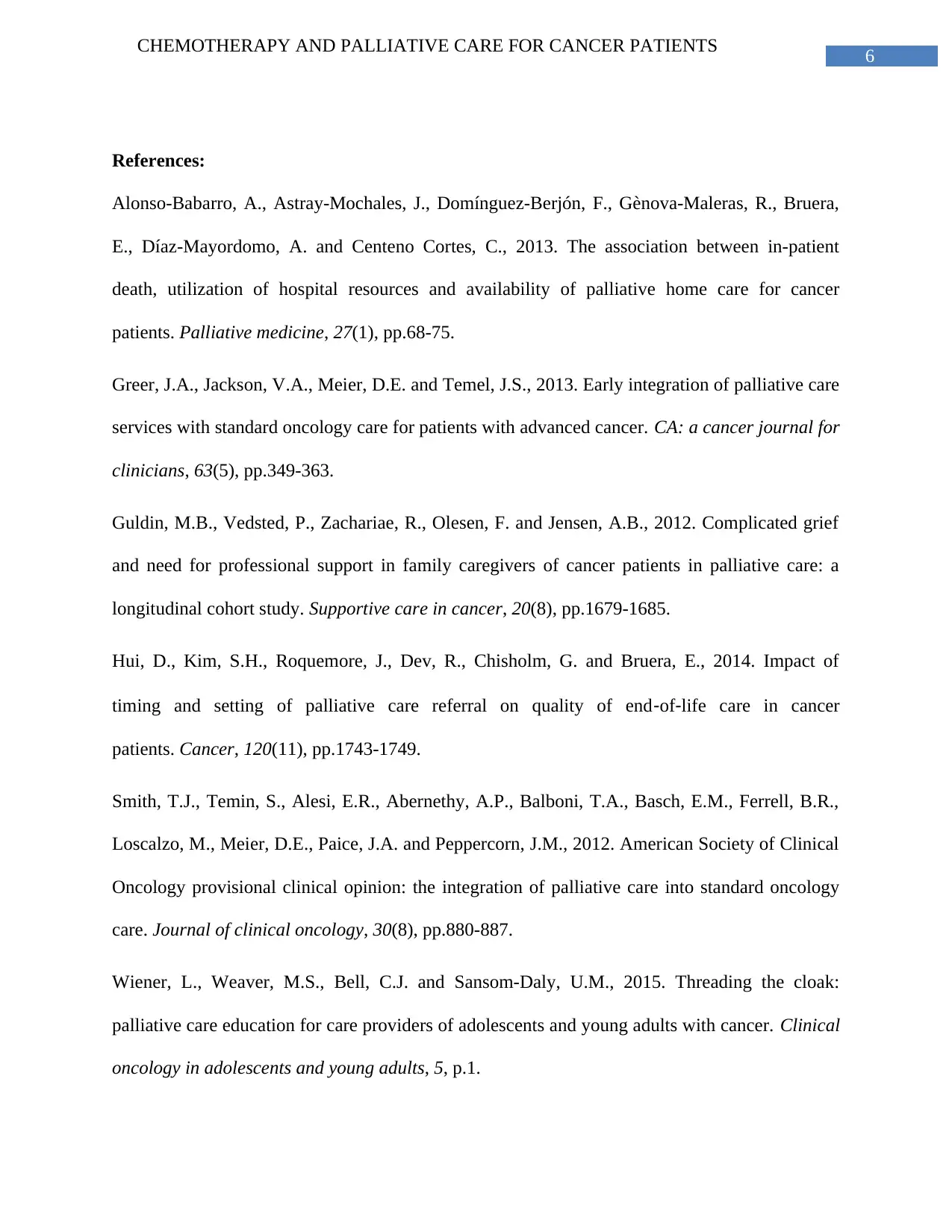
6
CHEMOTHERAPY AND PALLIATIVE CARE FOR CANCER PATIENTS
References:
Alonso-Babarro, A., Astray-Mochales, J., Domínguez-Berjón, F., Gènova-Maleras, R., Bruera,
E., Díaz-Mayordomo, A. and Centeno Cortes, C., 2013. The association between in-patient
death, utilization of hospital resources and availability of palliative home care for cancer
patients. Palliative medicine, 27(1), pp.68-75.
Greer, J.A., Jackson, V.A., Meier, D.E. and Temel, J.S., 2013. Early integration of palliative care
services with standard oncology care for patients with advanced cancer. CA: a cancer journal for
clinicians, 63(5), pp.349-363.
Guldin, M.B., Vedsted, P., Zachariae, R., Olesen, F. and Jensen, A.B., 2012. Complicated grief
and need for professional support in family caregivers of cancer patients in palliative care: a
longitudinal cohort study. Supportive care in cancer, 20(8), pp.1679-1685.
Hui, D., Kim, S.H., Roquemore, J., Dev, R., Chisholm, G. and Bruera, E., 2014. Impact of
timing and setting of palliative care referral on quality of end‐of‐life care in cancer
patients. Cancer, 120(11), pp.1743-1749.
Smith, T.J., Temin, S., Alesi, E.R., Abernethy, A.P., Balboni, T.A., Basch, E.M., Ferrell, B.R.,
Loscalzo, M., Meier, D.E., Paice, J.A. and Peppercorn, J.M., 2012. American Society of Clinical
Oncology provisional clinical opinion: the integration of palliative care into standard oncology
care. Journal of clinical oncology, 30(8), pp.880-887.
Wiener, L., Weaver, M.S., Bell, C.J. and Sansom-Daly, U.M., 2015. Threading the cloak:
palliative care education for care providers of adolescents and young adults with cancer. Clinical
oncology in adolescents and young adults, 5, p.1.
CHEMOTHERAPY AND PALLIATIVE CARE FOR CANCER PATIENTS
References:
Alonso-Babarro, A., Astray-Mochales, J., Domínguez-Berjón, F., Gènova-Maleras, R., Bruera,
E., Díaz-Mayordomo, A. and Centeno Cortes, C., 2013. The association between in-patient
death, utilization of hospital resources and availability of palliative home care for cancer
patients. Palliative medicine, 27(1), pp.68-75.
Greer, J.A., Jackson, V.A., Meier, D.E. and Temel, J.S., 2013. Early integration of palliative care
services with standard oncology care for patients with advanced cancer. CA: a cancer journal for
clinicians, 63(5), pp.349-363.
Guldin, M.B., Vedsted, P., Zachariae, R., Olesen, F. and Jensen, A.B., 2012. Complicated grief
and need for professional support in family caregivers of cancer patients in palliative care: a
longitudinal cohort study. Supportive care in cancer, 20(8), pp.1679-1685.
Hui, D., Kim, S.H., Roquemore, J., Dev, R., Chisholm, G. and Bruera, E., 2014. Impact of
timing and setting of palliative care referral on quality of end‐of‐life care in cancer
patients. Cancer, 120(11), pp.1743-1749.
Smith, T.J., Temin, S., Alesi, E.R., Abernethy, A.P., Balboni, T.A., Basch, E.M., Ferrell, B.R.,
Loscalzo, M., Meier, D.E., Paice, J.A. and Peppercorn, J.M., 2012. American Society of Clinical
Oncology provisional clinical opinion: the integration of palliative care into standard oncology
care. Journal of clinical oncology, 30(8), pp.880-887.
Wiener, L., Weaver, M.S., Bell, C.J. and Sansom-Daly, U.M., 2015. Threading the cloak:
palliative care education for care providers of adolescents and young adults with cancer. Clinical
oncology in adolescents and young adults, 5, p.1.
Paraphrase This Document
Need a fresh take? Get an instant paraphrase of this document with our AI Paraphraser
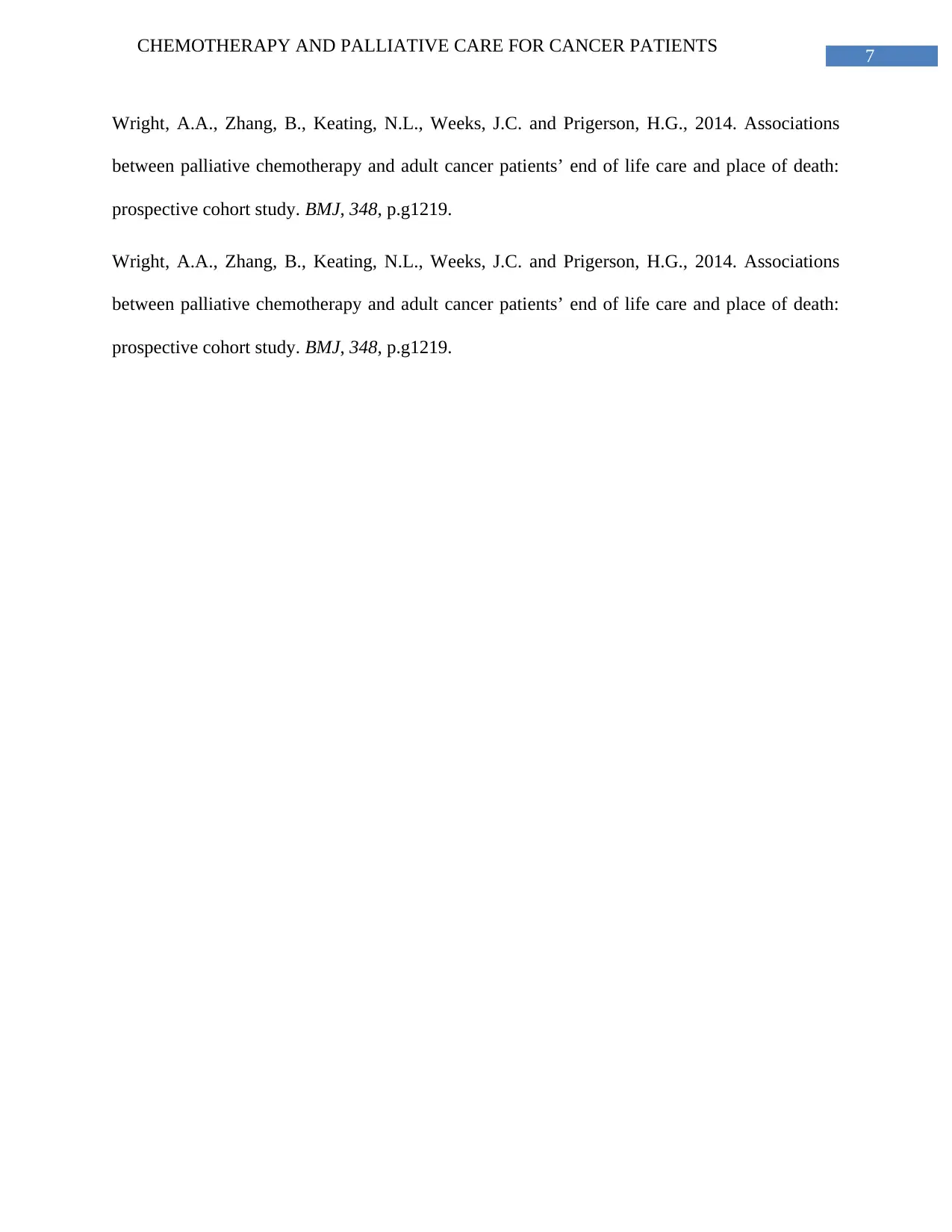
7
CHEMOTHERAPY AND PALLIATIVE CARE FOR CANCER PATIENTS
Wright, A.A., Zhang, B., Keating, N.L., Weeks, J.C. and Prigerson, H.G., 2014. Associations
between palliative chemotherapy and adult cancer patients’ end of life care and place of death:
prospective cohort study. BMJ, 348, p.g1219.
Wright, A.A., Zhang, B., Keating, N.L., Weeks, J.C. and Prigerson, H.G., 2014. Associations
between palliative chemotherapy and adult cancer patients’ end of life care and place of death:
prospective cohort study. BMJ, 348, p.g1219.
CHEMOTHERAPY AND PALLIATIVE CARE FOR CANCER PATIENTS
Wright, A.A., Zhang, B., Keating, N.L., Weeks, J.C. and Prigerson, H.G., 2014. Associations
between palliative chemotherapy and adult cancer patients’ end of life care and place of death:
prospective cohort study. BMJ, 348, p.g1219.
Wright, A.A., Zhang, B., Keating, N.L., Weeks, J.C. and Prigerson, H.G., 2014. Associations
between palliative chemotherapy and adult cancer patients’ end of life care and place of death:
prospective cohort study. BMJ, 348, p.g1219.
1 out of 8
Related Documents
Your All-in-One AI-Powered Toolkit for Academic Success.
+13062052269
info@desklib.com
Available 24*7 on WhatsApp / Email
![[object Object]](/_next/static/media/star-bottom.7253800d.svg)
Unlock your academic potential
Copyright © 2020–2025 A2Z Services. All Rights Reserved. Developed and managed by ZUCOL.





